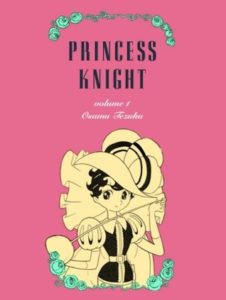Manga Review: Princess Knight by Osamu Tezuka
Once upon a time in the fairytale kingdom of Silverland, a child was born to the king and queen. Due to certain circumstances, there was a confused announcement about the child’s sex, and the people of Silverland decided to take it that the child was a boy. For only men could take the throne of Silverland, and the only male in the line of succession was Plastic, the mentally deficient son of the evil Duke Duralumin.
Although Sapphire had been born genetically female, the king came up with a plan to pass her off as male as he wasn’t too keen on letting Duke Duralumin take power as regent either. Thus it was that Prince Sapphire was presented to Silverland as its future ruler.
This might not seem like the most viable plan, but Sapphire had an extra secret. Due to the mistake of trainee angel Tink, Sapphire had been born with both a male and a female “heart,” and thus possessed the positive qualities of both genders. She excelled in both traditionally male and (secretly) female skills. And only a handful of the most trusted servants knew the truth.
The story picks up when Prince Sapphire is fifteen. She enjoys participating in traditionally masculine activities, particularly swordfighting, but chafes at having to hide her true self to do so. She wants to go to the festival and dance in a pretty dress, but must disguise herself as a blonde maiden to do so. It’s there she meets the handsome Prince Franz of neighboring Goldland and they hit it off. Pity she can never tell him the truth!
Meanwhile, Duke Duralumin and his henchman Sir Nylon step up their attempts to out Sapphire’s nature as a woman, figuring certain physical changes will make it harder to hide now. Plus Tink finally catches up with Sapphire. The small angel cannot return to Heaven unless he brings back her boy heart, but in the meantime Tink must protect Sapphire from the evil sorceress Madame Hell, who wants the prince’s girl heart for her daughter Hecate.
This was one of the first manga written specifically for the shoujo (girls’) market under the title of Ribon no Kishi (The Ribbon Knight) in 1953. Creator Osamu Tezuka had been strongly influenced by Disney cartoons, and that influence is never clearer than in the art and style of this story. In the 1960s an animated adaptation was made and given the title of “Princess Knight” when shown on American television, and Tezuka did a rewrite and expansion of the manga story at roughly the same time. (It is this 1966 version that was published in translation a few years back.)
This was pretty progressive stuff for 1950s Japan, depicting a heroine who was both bold and compassionate, a girl who would go ahead and rescue herself as often as not. In the end, she earns the right to rule not so much because of who her parents were, but because she has demonstrated her character throughout the story. Even the Sixties cartoon was a young SKJAM!’s first hint that gender roles are largely a social construct rather than innate.
But it’s also very much a story written by a man who reached adulthood in the 1940s, and especially the first volume of two contains a lot of gender essentialism. It’s very strongly implied that Sapphire’s courage and martial skill come from her boy heart, as she falters when it’s temporarily removed. The second volume has women warriors who do not require an extra heart to be badass, and Sapphire herself shows that she’s outgrown that need.
Parents of young readers should also be aware that there’s a lot of death in this series, both villains and lovable good people. And Tink’s boss is kind of a jerk for working in Heaven. “You can return home–or sacrifice that forever to save Sapphire’s life.” It’s a children’s series, but perhaps it is best read together to discuss some of the themes.
Oh, and Prince Franz is a bit of a dunderhead who does not figure out that Sapphire and the blonde girl he loves are the same person despite learning fairly early on that Sapphire is physically female and having multiple clues. He continues to be a bit obtuse in the sequel about their children, Twin Knights.
Recommended to fans of children’s fantasy, especially girls.


